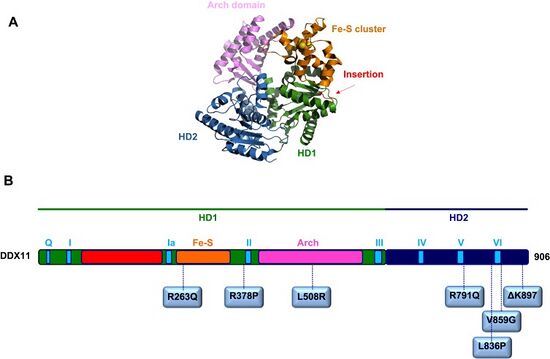Warsaw breakage syndrome
| Warsaw breakage syndrome | |
|---|---|
| Other names: WABS[1] | |
Warsaw breakage syndrome (Warsaw syndrome, WABS) is a rare genetic condition. Fewer than 10 cases have been reported by 2018.[2] Its clinical manifestations affect several organ systems, and includes microcephaly and severe growth retardation among others.
Signs and symptoms
- Severe pre- and postnatal growth retardation
- Microcephaly
- Intellectual disability
- Dysmorphic features
- Small and elongated face
- Narrow bifrontal diameter
- Prominent cheeks
- Small nares
- Flat philtrum
- Relatively large mouth
- Bilateral epicanthal folds
- High arched palate
- Microretrognathism
- Coloboma of the optic disc
- Strabismus
- Cup-shaped ears
- Sensorineural deafness
- Short neck
- Jugular hypoplasia
- Cardiac features
- Ventricular septal defect
- Tetralogy of Fallot
- Sketelal features
- Clinodactyly of the fifth fingers
- Syndactyly of the second and third toes
- Small thumbs
- Small fibulae
- Others
- Abnormal skin pigmentation
- Single palmar crease
Israeli Health Ministry describes the condition manifestation as "characterized by smaller than average head circumference (microcephaly) as early as the embryonic stage, intrauterine growth restriction (IUGR) as well as postnatal growth restriction (dwarfism). Furthermore, patients born with this condition experience hearing impairments, moderate to significant developmental delays, skeletal disorders and heart disorders (40%), as well as disorders to various body systems such as the renal and urogenital systems. In some patients, blood tests indicate increased chromosome fragility. Some fetuses die in utero (intrauterine fetal demise)."[5]
Genetics

This condition is caused by mutations in the DDX11 gene.[4][6]
DDX11 mutation that causes WABS is described at US National Library of Medicine:[7]
The DDX11 gene provides instructions for making an enzyme called ChlR1. This enzyme functions as a helicase. Helicases are enzymes that attach (bind) to DNA and temporarily unwind the two spiral strands (double helix) of the DNA molecule. This unwinding is necessary for copying (replicating) DNA in preparation for cell division, and for repairing damaged DNA and any errors that are made when DNA is copied. In addition, after DNA is copied, ChlR1 plays a role in ensuring proper separation of each chromosome during cell division. By helping repair errors in DNA and ensuring proper DNA replication, the ChlR1 enzyme is involved in maintaining the stability of a cell's genetic information. DDX11 gene mutations severely reduce or completely eliminate ChlR1 enzyme activity. As a result, the enzyme cannot bind to DNA and cannot unwind the DNA strands to help with DNA replication and repair. A lack of functional ChlR1 impairs cell division and leads to an accumulation of DNA damage. This DNA damage can appear as breaks in the DNA, giving the condition its name. It is unclear how these problems in DNA maintenance lead to the specific abnormalities characteristic of Warsaw breakage syndrome.
This gene encodes an iron-sulfur containing DNA helicase that belongs to the Fe–S DNA helicases.[3] This protein interacts with the 9-1-1 checkpoint complex protein.[citation needed]
The inheritance pattern is autosomal recessive.[2][5] Condition is very rare, but its prevalence in Ashkenazi Jews population is about 1/50.[5][7]
Diagnosis
The evaluation of Warsaw breakage syndrome is based on the following:[4]
- Clinical findings
- Genetic testing
Differential diagnosis
The DDX should be based on the following:[citation needed]
- Bloom syndrome
- Cornelia de Lange syndrome
- Fanconi anemia
- Nijmegen breakage syndrome
- Roberts syndrome
- Xeroderma pigmentosum
Treatment
There is no known curative treatment for this condition presently. Management is supportive.[4]
History
This condition was first described in 2010.[8]
References
- ↑ "OMIM Entry - # 613398 - WARSAW BREAKAGE SYNDROME; WABS". omim.org. Archived from the original on 20 September 2019. Retrieved 29 October 2019.
- ↑ 2.0 2.1 Alkhunaizi, Ebba; Shaheen, Ranad; Bharti, Sanjay Kumar; et al. (November 2018). "Warsaw breakage syndrome: Further clinical and genetic delineation". American Journal of Medical Genetics Part A. 176 (11): 2404–2418. doi:10.1002/ajmg.a.40482. PMC 6289708. PMID 30216658.
- ↑ 3.0 3.1 3.2 Pisani, Francesca M. (2019). "Spotlight on Warsaw Breakage Syndrome". The Application of Clinical Genetics. 12: 239–248. doi:10.2147/TACG.S186476. ISSN 1178-704X.
- ↑ 4.0 4.1 4.2 4.3 Alkhunaizi, Ebba; Brosh, Robert M.; Alkuraya, Fowzan S.; Chitayat, David (1993). "Warsaw Syndrome". GeneReviews®. University of Washington, Seattle. Archived from the original on 2023-06-01. Retrieved 2023-11-12.
- ↑ 5.0 5.1 5.2 "Warsaw Breakage Syndrome". GOV.IL. Archived from the original on 9 April 2023. Retrieved 9 April 2023.
- ↑ "DDX11 gene: MedlinePlus Genetics". medlineplus.gov. Archived from the original on 9 April 2023. Retrieved 9 April 2023.
- ↑ 7.0 7.1 "Warsaw breakage syndrome: MedlinePlus Genetics". medlineplus.gov. Archived from the original on 13 April 2023. Retrieved 9 April 2023.
 This article incorporates text from this source, which is in the public domain.
This article incorporates text from this source, which is in the public domain.
- ↑ van der Lelij, Petra; Chrzanowska, Krystyna H.; Godthelp, Barbara C.; Rooimans, Martin A.; Oostra, Anneke B.; Stumm, Markus; Zdzienicka, Małgorzata Z.; Joenje, Hans; de Winter, Johan P. (February 2010). "Warsaw Breakage Syndrome, a Cohesinopathy Associated with Mutations in the XPD Helicase Family Member DDX11/ChlR1". The American Journal of Human Genetics. 86 (2): 262–266. doi:10.1016/j.ajhg.2010.01.008. PMC 2820174. PMID 20137776.
| Classification |
|---|